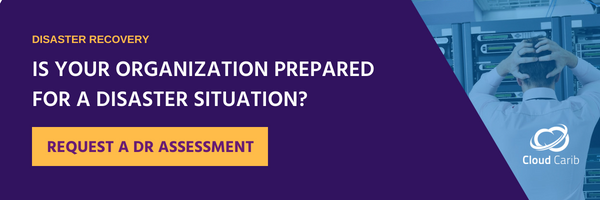.png?width=1024&name=DR%20-%20Start%20Here%20(2).png)
It’s never too early to start preparing for hurricane season. Ensuring that your organisation has the necessary infrastructure in place to continue operations in a disaster situation is a key component of any good business continuity plan. Research from the past several years has shown a huge increase in both the activity and intensity of storms. In recent years, catastrophic storms left many in The Caribbean without power, food, and shelter for days, weeks, and months and have forced some to relocate permanently.
The only way to prevent and protect your business from the unpredictable aftermath of a hurricane is by being prepared. This starts with having a sophisticated disaster recovery plan in place to ensure your organization can continue operating. Below, we take a deeper dive into some disaster recovery strategies and reveal the best ways to prepare your IT environment and infrastructure for hurricane season.
1. Understand How Much Your Organization Can Afford to Lose
The first step toward building a successful disaster recovery plan is to understand how much your organization can afford to lose. This includes determining how much downtime is acceptable and what the effect could be on your organization’s bottom line. To help calculate how much an outage could cost your business, you can use our handy downtime calculator.
By understanding the potential impact of a disaster on your organization, IT teams can accurately develop disaster recovery plans with appropriate SLAs and infrastructure in place to protect critical workloads and applications.
2. Calculate Your RPO and RTO Targets
Two important parameters that help to define an effective disaster recovery plan are the Recovery Point Objective (RPO) and Recovery Time Objective (RTO). The RPO measurement defines the last point in time systems and applications can be recovered and measures the amount of data that will be lost during potential downtime. The RTO measurement is the amount of time it takes to recover data and applications after an outage, and how long it will take to resume back to normal business operations.
It is imperative the RPO and RTO targets are in line with your SLAs to minimize the loss of data, revenue, and productivity. The cost of downtime associated with lost data and recovering lost data can be significant for an organization. Therefore, having appropriate SLAs in place that makes sense for your business is crucial for a robust disaster recovery plan.
3. Failover to a Secondary Data Centre Location
Whether you house your IT equipment on or off-premise, it is important to have a reliable secondary environment ready to failover to. For Caribbean-based organizations, this could mean having a secondary data centre on another island, or in Latin America away from the hurricane zone. When disaster strikes, you can have some peace of mind knowing your infrastructure will failover to a secondary site and can continue operating business as usual.
Failing over to a secondary environment better prepares your organisation by dramatically reducing your disaster response time. With proper training and testing, employees can quickly pick up where they left off safely and securely while continuing to generate revenue without any bottlenecks in communication.
4. Partner with a Managed Service Provider
Outsourcing the management of your IT infrastructure or disaster recovery solution to an experienced managed service provider (MSP), like Cloud Carib, will help your organization maintain normal business operations during a hurricane or disaster situation. An MSP can help monitor your systems and applications and provide 24/7 support when and if your environment experiences downtime. If your MSP is regional or has several data centre locations, they can ensure your disaster recovery plan is efficient by failing over to a secondary site away from the disaster location.
An MSPs job is to ensure you can maintain your organisation’s infrastructure and ensure its uptime and availability. When leveraging your MSP correctly, your team can be alleviated mundane tasks and enable your internal IT department to focus on more strategic initiatives. Choosing an experienced MSP provides exponential value.
5. Test Your Disaster Recovery Plan Often
Having a disaster recovery plan in place is only half the battle – your organization needs to be able to test the plan to ensure it performs as expected. This also means training employees on disaster protocols. The industry standard is to test your DR plan bi-annually, or whenever there is a significant change to your environment to ensure you are ready for a declared disaster.
Now is the time to start planning an effective disaster recovery strategy and testing any plans already in place. If you don’t know where to start, take our free Risk Assessment quiz to test your organisational readiness.
